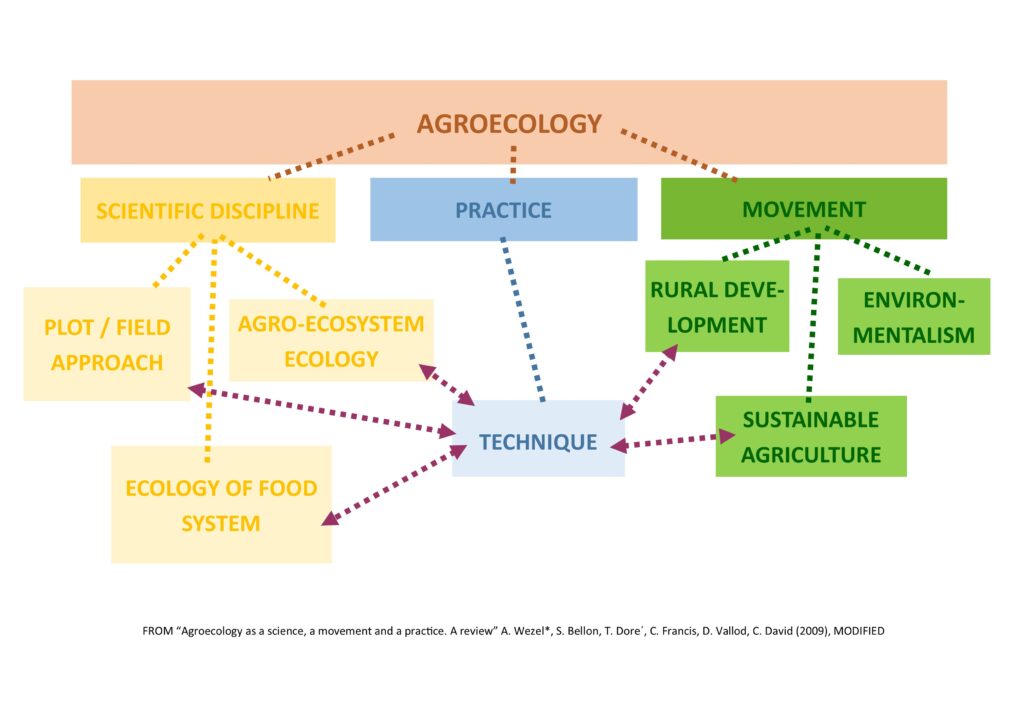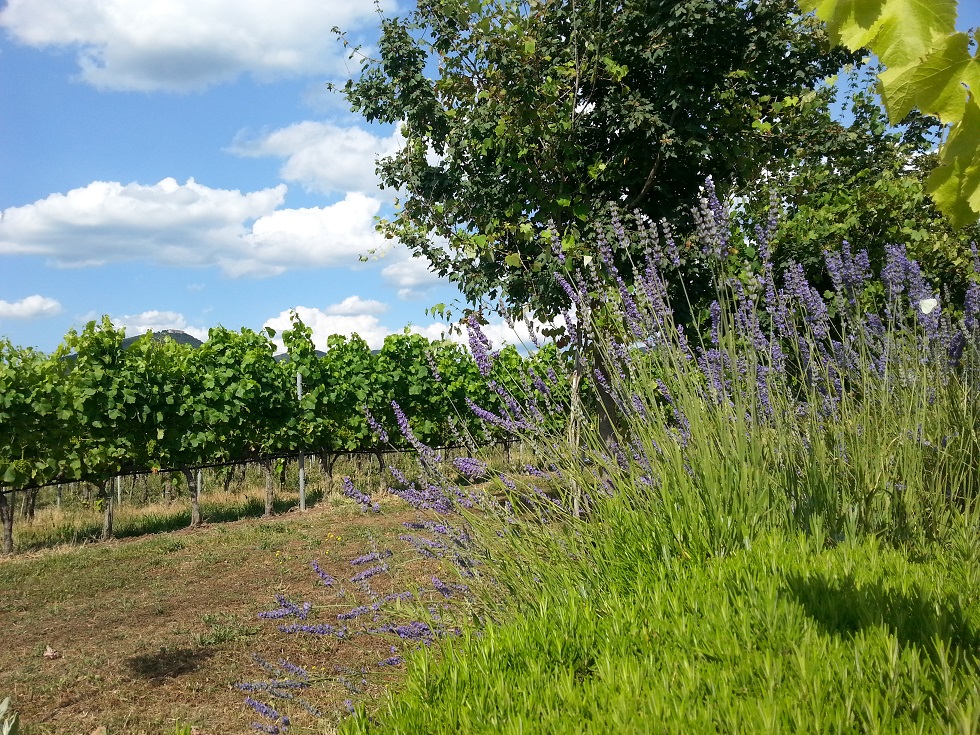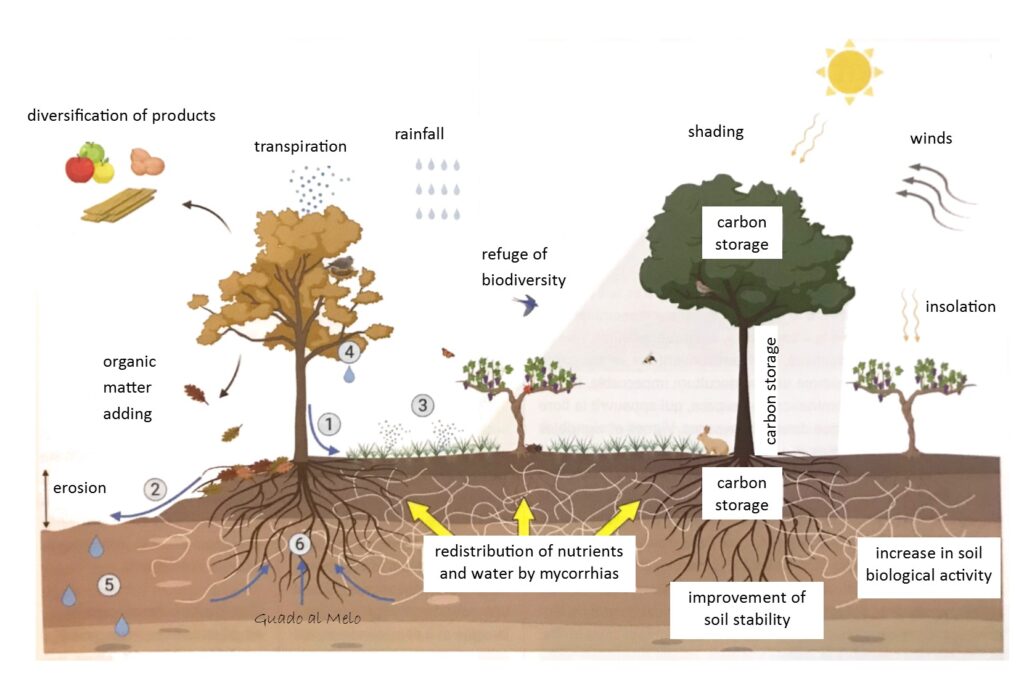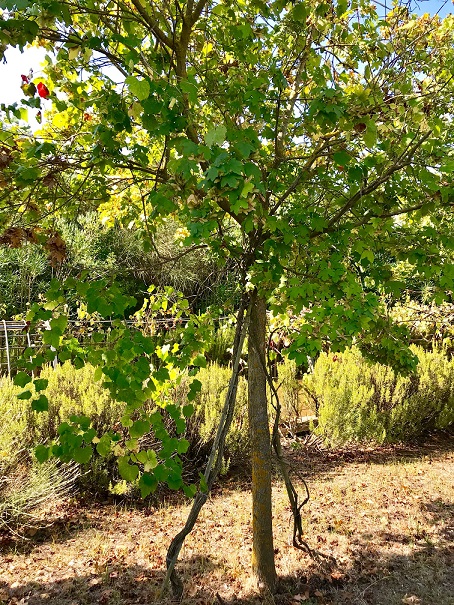The visitors to our vineyards and territory are particularly struck of finding an uncontaminated environment. They are impressed by our grassy vineyards, made by little particles bordering the wood, alternating with rows of olive trees, fruit trees and hedges. This vineyard managing (perfectly integrated into the environment and in association with other plant species) is the result of an ancient tradition and precise agronomic and environmental choices, which arise from agroecological studies.
[one_second][info_box title=”What agroecology is?” image=”” animate=””]
Agroecology arises from the fusion of two areas that may seem, at first, very distant: agriculture and ecology. Ecology deals with studying the relationships of a living being with its environment and with the other living beings that populate it. Agroecology applies this approach to a very particular ecosystem, the agroecosystem, the one domesticated and managed by man.
Agroecology was born around the 1960s as a science that studies these aspects in an interdisciplinary way. It has also taken on the characteristics of a political movement in Latin America, integrating within it all the management of the human food system.

Agroecology is one of the key concepts in sustainable management of viticulture. In particular, it concerns the integration of the vineyard in the environment and the preservation of its biodiversity. In other words, on agroecological vision, the vineyard is considered as an integrated ecosystem, where various subjects interacting with each other (vines, surrounding flora and fauna). If appropriately managed, this ecosystem can find an optimal balance, both for better cultivation and for preserving the environment and the landscape.

I focus this article on the association of the vine with other plant species, but the same happens with the animal world. A classical example is the application of biological control, based on some insects or mites which carry out their life cycle at the expense of species harmful to the vine. In the recent decades, interactions with even smaller organisms, such as bacteria and fungi, are increasingly being understood. Some of them are harmful, but some instead have interchange functions with the plant, which lead to precious symbionic associations (where both partners get something useful). The best known example is that of mycorrhias, fungi that colonize outside and inside the roots of the vine. This association significantly improves the supply of water and mineral nutrients, as well as the photosynthetic capacity in general. The most recent studies are also increasingly focusing on the microbiota that populates the vine leaves (the set of populations of microorganisms that live in these spaces). Several of them seem to play an important role in maintaining the health of the plant. Some bacteria have been shown to inhibit or delay the growth of harmful fungi for the vine. Some practical applications are also being developed. [/info_box][/one_second]
The amazement of these people is due to the fact that the viticultural landscape of many wine world areas is often very different. It derives from a different management, born with the modern era of winegrowing, which isolates the vine as much as possible from all living forms: bare soil, large areas of vineyards, excessive use of pesticides that (almost) “sterilize” the vines. This model, which has dominated for decades, has now shown all its limits.
The agroecological management of the vineyard was often considered a niche choice, a wrong legacy of the past or a bucolic vision by radical winegrowers (as someone told us!). Today, however, it is increasingly affecting the wine world. More and more scientific publications recognize this system as a valid agronomic model, which represents the best prospect for an increasingly sustainable future of viticulture.
The plant intercropping in the vineyard is part of Italian tradition from thousands of years, even if this approach has been lost in many territories. The most common viticulture in the history has been heterogeneous, with vine rows of vines alternating with other crops. Moreover, the trees often were the support of the vines. Do you remember the “married” vine to a tree, originated in the Etruscan-Roman epoc? It remained the main winegrowing form in the countryside of central-northern Italy until the mid-twentieth century. (I’ve talked about it several times, mostly here and here).
My talk is not about a naïve or old-fashioned winegrowing. Certainly, the modern era of viticulture has made us learn a lot, but it has also had indisputable excesses. By now, we have understood that viticulture must be sustainable from all points of view: not only for an optimal production but also for the protection of the environment and our health. To achieve this, we have to do the best synthesis between the different paths, taking the best of each.
Research is increasingly demonstrating that the association of vines with other plant species contributes to improving various aspects of viticulture, as part of a whole sustainable management. Let’s see, in brief, the main advantages.
The most immediate positive aspect is on the landscape. The geometric lines of huge extensions of monocultures can have some charm. But a landscape where different elements alternate is certainly more beautiful and satisfying. Beauty is not a negligible factor, it fills our eyes and heart. However, the agroecological management does not stop at a beautiful postcard. It gives even more important advantages, both of natural environmental and agronomic, as we shall see below.
An environment rich in different plant species allows greater preservation of biodiversity and the environment. Today, there is a lot of talk about biodiversity in the vineyard and its usefulness on biological control. It is easy to realize that insects or other useful organisms can’t try their best life condition in a monoculture environment, where also there are a large use of pesticides often. An environment with numerous plant species is much more attractive. It has many blooms for many months, as well as offering different habitats. Moreover, the vineyard also becomes a sort of “green passageway”, which can be crossed by small animals, in their movements among woods and scrubes.water cycle
Research has shown how the presence of trees, shrubs and grass affects the micro-climate of the vineyard. Climate changes are leading to increases in average temperatures, which are causing more and more phenomena of acceleration of grape ripening. Extreme meteorological events are also becoming increasingly frequent, such as torrential rainfall, accentuated drought, etc. The presence of vegetation may be not decisive, but it improves the situation. For example, hedges and trees can be an obstacle to strong winds. The presence of rich vegetation improves local hydrometry, thanks to the transpiration-evaporation of the leaves. The effects of frosts also decrease. On the other hand, in warmer environments, partial shading contrasts the stresses due to thermal excesses and a too intense solar radiation, …
Trees, shrubs and grass cover have an important influence on improving the quality of the soil. They cause an increase in organic matter and the biological activity of the rhizosphere. One of the most important problems of our Mediterranean climate is the low average presence of organic matter in the soils, due to mineralization cycles that are too accelerated by high temperatures. The numerous roots that explore the soil at different depths facilitate the exchange of matter, as well as helping to maintain a certain porosity that buffers excess water and, on the other hand, reduces drying and erosion.
In general, all the energy flows change: light irradiation, wind turbulence, water and nutrient cycle. For example, studies have highlighted the differences of the carbon fixation cycle in situations of “bare” vineyards compared to intercropping ones, to clear advantage of the latter
In particular, the presence of a rich vegetation determines a positive effect on the rhizosphere microbiota. So, the soil is more rich in fungi, bacteria, earthworms, etc. The presence of mycorrhias increases, because these not only colonize the vines but also other tree species. These fungi, as demonstrated, have positive effects on the photosynthetic capacity of plants but also on their ability to explore the soil for the supply of mineral salts and water. The extra-radical mycelium of the mycorrhias can colonize several plants at the same time, both vines and others, creating a sort of inter-specific cenosis. The presence of more plant species can lead to a greater differentiation of the mycorrhizae present, compared to monoculture, increasing the probability of their spread and survival. The presence of diversified communities of mycorrhias has also been shown to speed up the colonization time of the roots of young vines.

The traditional heterogeneous winegrowing derives from ancient practices, sometimes done with wisdom, sometimes casual. Today, the vineyard agroecology born from studies on the parcel to understand the best arrangement of trees and bushes, the choice of the best species both as essences and as size, etc.
However, I believe that the presence of local species, even spontaneous ones, creates a specific association that is much more interesting than too-constructed projects, also falling within the general concept of genius loci (or viticultural terroir) of that vineyard. We must not forget that one of the main goals of sustainable viticulture should be to minimize human inputs. I think that a too artificial construction of a “false” naturalness is a contradiction, overall if it needs continuous human interventions to be maintained. Optimal management should lead to an agro-ecosystem that balances itself without external interventations as much as possible.
For example, the spontaneous meadow has undoubted advantages over the sown one. Numerous studies have shown that the accumulation of nitrogen available in the soil thanks to the green manuring of some legumes is not significantly different from what can be obtained with spontaneous meadow. If there are no other obstacles, why not leave it to nature, avoiding continuous sowing? The ecological and management advantages are evident: the uses of the tractor are limited (fuel consumption is reduced and too many inputs that compact the soil are avoided), expenses are reduced (it is useless to buy seed when the lawn regenerates from itself), etc. I think it is a contradiction to talk about biodiversity in the vineyard and then set up monoculture also in the soil covering. The spontaneous meadow develops different species, that bloom in different times, in order to create an environment more in tune with the seasons, much more attractive for the local micro-fauna.
I conclude by returning to what is the highest form of association of the vine with other plant species: the vine “married” to the tree, that we have been studying in the field at Guado al Melo for several years. This traditional ancient form is snubbed by the Italian wine world. There is a closure: this vine-training system is seen as old and useless.

Curiously, I am finding instead more and more interest on “married vines” in the worldwide professional literature. More and more, I find articles and books on the subject, as in the special of the Revue des Oenologues that I quote at the bottom.
As I have already told in the final part of this article, the Romans brought this vine-training system from Italy to the rest of Europe. The French historically abandoned the “married” vine long before us, but they are returning to rediscover it as a interesting path for a more sustainable future of viticulture. For example, the OIV has awarded as best book of 2020 for sustainable viticulture (“durable“, in French), a text that talks about intercropping between vine rows, including the “married vine” training system. I’m talking about “La vigne et ses plantes compagnes” by Léa Darricau and Yves Darricau, ed. La Rouergue (2019).
I want to invite the world of Italian wine to wake up. As has already happened too many times for many wine issues, will we wait to understand the importance of our tradition when the French will have taken it in the world as their? Will it seem interesting to us then? Let’s meditate!
“Pratique viticoles inspirantes – Agroécologie en action au service du vivant”, Revue des Oenologues.., Dossier Spécial, Nov. 2020, n.177
“Agroecology as a science, a movement and a practice. A review” A. Wezel*, S. Bellon, T. Dore´, C. Francis, D. Vallod, C. David (2009), Agronomy for Sustainable Development29(4):503-515
“Vine Roots”, by E. Archer and D. Saayman, 2018 The Institute for Grape and Wine Sciences, Stellenbosch University
“La nuova viticultura”, a cura di A. Palliotti et al., 2015, Edagricole.